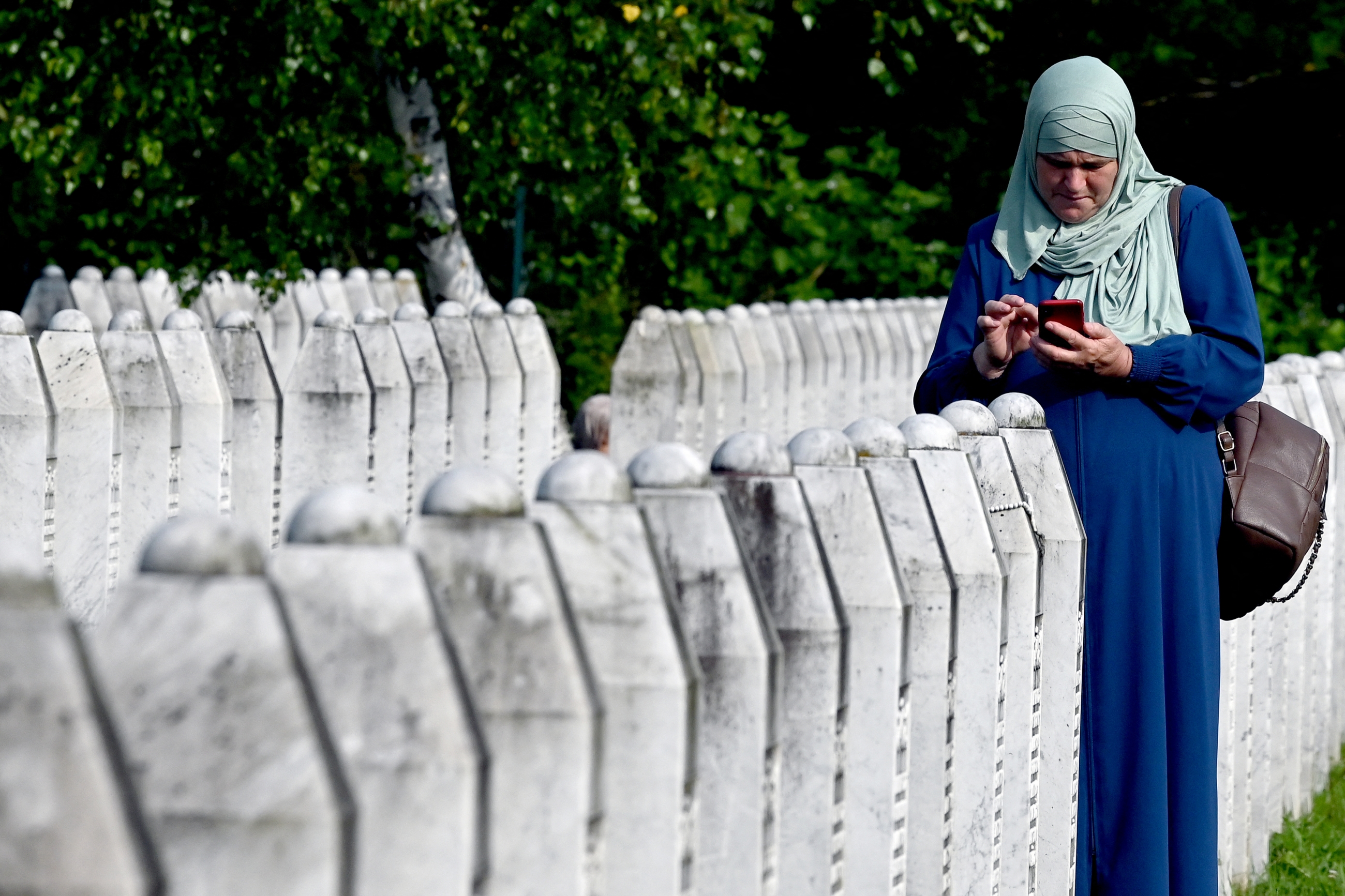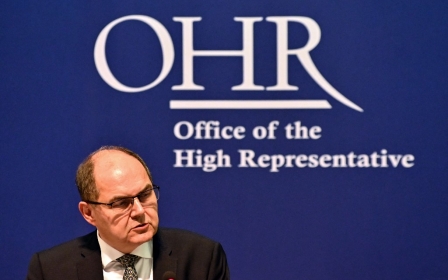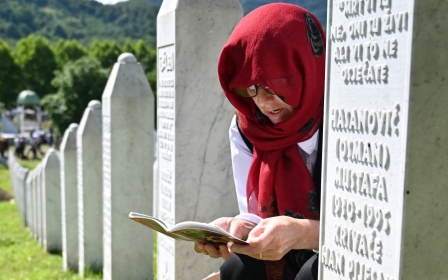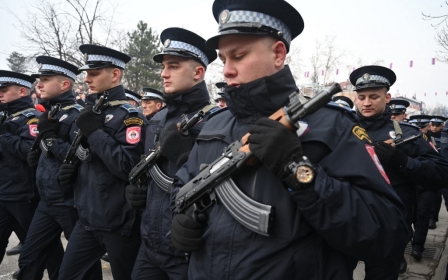Srebrenica anniversary: How to counter Bosnian genocide denial

This 11 July marks the 28th anniversary of the Srebrenica genocide in what was the most brutal phase of the Bosnian genocide perpetrated by Bosnian Serb forces from 1992 to 1995.
Aided and abetted by the regime in neighbouring Serbia, starting in the spring of 1992, Bosnian Serb rebel forces attacked the legitimate and internationally recognised state of Bosnia and Herzegovina, unleashing a campaign of terror against the Bosniak population.
On top of this, the UN-imposed arms embargo curtailed Bosnia’s ability to defend itself. The result was the worst atrocities committed in Europe since the Second World War.
New MEE newsletter: Jerusalem Dispatch
Sign up to get the latest insights and analysis on Israel-Palestine, alongside Turkey Unpacked and other MEE newsletters
In the summer of 1992, several brave western journalists gained access and reported on the Bosnian Serb-run concentration camps in northwestern Bosnia. The sight of emaciated men and boys behind barbed wire in Europe at the close of the 20th century sprung many pro-Bosnian voices and activists in the US and beyond to action to end the war. The places of Prijedor, Omarska and Keraterm became synonyms for camps, death and torture.
Downplaying genocide
In eastern Bosnia, along the River Drina bordering Serbia proper, unspeakable atrocities were committed by Bosnian Serb forces and henchmen from the next-door state. The towns of Zvornik, Visegrad and Foca came to symbolise mass suffering and the elimination of the Bosniak population in this part of the country.
The genocide was not perpetrated only over a few days but was the culmination of a three-and-a-half-year project to wipe out the Bosniak population
The capital city of Sarajevo was under siege for more than three-and-a-half years, rendering it the longest siege in modern history. Conditions in the city were dire with shelling and snipers constantly terrorising the citizens.
Of the numerous sites of atrocities and genocide across Bosnia, Srebrenica was the most brutal stage of the genocide and the most documented with the killing of more than 8,000 Bosniak men and boys.
Yet the genocide was not perpetrated only over a few days in July 1995 in this eastern Bosnian town. Srebrenica was, in fact, the culmination of a three-and-a-half-year project to wipe out the Bosniak population from territories that Bosnian Serbs occupied and wanted to carve out a state of their own.
While journalists, observers, academics and activists in the early 1990s recognised the identical pattern of genocide across Bosnia, a different narrative over the years took on a life of its own. The 1992-1995 Bosnian genocide started being reduced geographically and temporally to a Srebrenica genocide in July 1995.
A number of actors took part in this denial over the years. The perpetrators and their enablers started with the denial immediately in 1992 and have continued to this day. Opponents of international military intervention in Bosnia, especially in Europe, resorted to using the term "ethnic cleansing" instead of genocide.
The motive was to dampen calls and support for military intervention as the term genocide implied a responsibility to act based on the 1948 Genocide Convention.
In the post-war period, a number of western-funded NGOs active in Bosnia began downplaying the scale and scope of the genocide. "Reconciliation" became the buzzword. For these organisations, genocide became a topic to be avoided.
Furthermore, some of these western projects introduced postmodernism as a form of genocide denial putting forth ideas that there were "multiple truths" and "alternative narratives". These were, in fact, forerunners of "alternative facts" before the latter was even articulated.
Starting in 2001, the International Criminal Tribunal for the Former Yugoslavia (ICTY) contributed its share to minimising the genocide. In the Radislav Krstic case, the ICTY found the former aide to Bosnian Serb General Ratko Mladic guilty of genocide in Srebrenica. This established a pattern in which subsequent court verdicts recognised genocide only in Srebrenica while failing to address the same crime committed across Bosnia.
Despite overwhelming evidence, academic works and court judgments, the denial of the Bosnian genocide is rampant. The hope that a younger generation in the Bosnian administrative entity of Republika Srpska would accept the truth turned out to be grossly misplaced.
In fact, two young politicians who were seen by international observers and even some Bosnians as offering hope for the future - Banja Luka mayor Drasko Stanivukovic and his ally-turned-rival Jelena Trivic – both deny the genocide.
A different approach
In facing growing genocidal denial, a burning question is how this trend should be countered. For years, a number of NGOs in Bosnia believed - or at least claimed to believe - that the best response was to engage the younger generations across the ethnic divide, foster youth exchanges and encourage dialogue.
However, this has produced no worthwhile result.
Bosniak politicians should advocate for parliaments around the world to recognise the genocide and declare 11 July as a Bosnian Genocide Remembrance Day
For Bosniaks, a different approach is needed. The way forward is not to engage deniers but to bypass them. Instead of local and regional engagement, the best avenue is a regional and global commemoration of the Bosnian genocide.
To preserve the memory of the genocide, Bosniak intellectuals, activists, politicians and others need to make their case globally. It is only by reaching far beyond the Balkans that the pernicious effects of genocide denial can be countered.
Academics, researchers and journalists have to publish more in English in prestigious media outlets and highly-regarded publishing houses. Bosniak filmmakers need to tell the stories of concentration camps and life and death in Sarajevo and Srebrenica through feature films in English.
A Hollywood feature film will tell the story of the Bosnian genocide to a global audience.
Bosniak parliamentarians should advocate for parliaments across the globe to recognise the genocide and declare 11 July as a Bosnian Genocide Remembrance Day. Mayors should encourage their colleagues in the US, the EU, and the Middle East to name a street in major cities after Srebrenica. City councils can pass resolutions commemorating 11 July.
Bosniak businessmen and Bosnia-friendly entrepreneurs can endow chairs in Bosnian genocide studies at well-regarded universities in the US. This would ensure that memory is preserved in the younger generation of students.
In sum, the reality of genocide denial is here to stay. Instead of unfounded hopes that the passage of time will dampen denial, it is crucial to undertake concrete steps beyond Bosnia’s borders to ensure that the genocide in Europe in the 1990s is not forgotten.
The views expressed in this article belong to the author and do not necessarily reflect the editorial policy of Middle East Eye.
Middle East Eye delivers independent and unrivalled coverage and analysis of the Middle East, North Africa and beyond. To learn more about republishing this content and the associated fees, please fill out this form. More about MEE can be found here.






